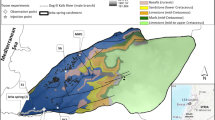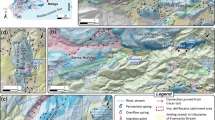Abstract
Karst aquifers contribute to supplying drinking water to almost a quarter of the world´s population. Their complex dynamics requires specific approaches aimed at recognizing their singularities, analyzing its vulnerability, and ensuring water resources quality. In this paper, the results of processing and modeling five breakthrough tracer curves obtained under different hydrodynamic conditions in the main conduit of Egino karst aquifer (Basque Country, Spain) are analyzed together with those involving pressure injections of the tracer in the saturated zone of the karst massif recharge area. In the conduit, transport is immediate and highly efficient (recovery rates above 84% and dispersion coefficients from 15.04 to 84.35 m2/min); tracer retentions increase as flow rates decrease and no significant contributions to its surroundings are observed. In contrast, tracer transport from the massif recharge area is more complex: after injection at a pressure of 1 MPa, most tracer remains in the surrounding of the injection borehole, retained in a saturated medium of low effective fracture porosity (ϕ f = 1.02 × 10−4, assuming a radial divergent flow model); subsequently, the main tracer mobilization to the spring was registered with the first rains, with 0.088 m/min mean velocity and high concentrations per unit mass being injected (C p /M0 = 0.03 mg/L/kg), which is evidence that the tracer reaches soon the karst conduit network. In any case, a decreasing tracer presence is registered at the injection zone during a hydrological cycle. In both cases, the observed non-linearity of transport processes should be considered in the development of vulnerability approaches, modeling efforts, and mapping. Furthermore, in the case of karst massif recharge areas, as the presence of pollutants may have a significant impact on the springs and persist over time, their management and protection needs must be revised in each specific site. Simultaneously, quality-monitoring programs at the springs must be adapted to the aquifers recognized dynamics.








Similar content being viewed by others
References
Andreo B, Ravbar N, Vías JM (2009) Source vulnerability mapping in carbonate (karst) aquifers by extension of the COP method: application to pilot sites. Hydrogeol J 17:749–758. https://doi.org/10.1007/s10040-008-0391-1
Angulo B, Morales T, Uriarte JA, Antigüedad I (2011) Hydraulic conductivity characterization of a karst recharge area using water injection tests and electrical resistivity logging. Eng Geol 117:90–96. https://doi.org/10.1016/j.enggeo.2010.10.008
Aral H, Vecchio-Sadus A (2008) Toxicity of lithium to humans and the environment—a literature review. Ecotoxicol Environ Saf 70:349–356. https://doi.org/10.1016/j.ecoenv.2008.02.026
Bakalowicz M (2005) Karst groundwater: a challenge for new resources. Hydrogeol J 13:148–160. https://doi.org/10.1007/s10040-004-0402-9
Benischke R, Goldscheider N, Smart C (2007) Tracer techniques. In: Goldscheider N, Drew D (eds) Methods in karst hydrogeology. Taylor and Francis, London, pp 147–170
Birk S, Geyer T, Liedl R, Sauter M (2005) Process-based interpretation of tracer tests in carbonate aquifers. Ground Water 43:381–388. https://doi.org/10.1111/j.1745-6584.2005.0033.x
Bottrell SH, Atkinson TC (1992) Tracer study of flow and storage in the unsaturated zone of a karstic limestone aquifer. In: Hötzl H, Werner A (eds) Tracer hydrology. Balkema, Rotterdam, pp 207–211
Brouyère S (2004) A quantitative point of view of the concept of vulnerability. In: Zwahlen F (ed) Vulnerability and risk mapping for the protection of carbonate (karst) aquifers, COST620 final report. Office for Official Publications of the European Communities, Luxembourg, pp 10–15
Castany G, Margat J (1977) Dictionnaire français d’hydrogéologie. BRGM, Orléans
Čenčur Curk B, Trček B, Veselič M (2001) The study of solute transport with natural and artificial tracers at experimental field site Sinji Vrh. RMZ Mater Geoenviron 48:401–413
Cerdà A, Schnabel S, Ceballos A, Gomez-Amelia D (1998) Soil hydrological response under simulated rainfall in the Dehesa Land System (Extremadura, SW Spain) under drought conditions. Earth Surf Process Landf 23:15–209
Chen JS, Chen CS, Chen CY (2007) Analysis of solute transport in a divergent flow tracer test with scale-dependent dispersion. Hydrol Process 21:2526–2536. https://doi.org/10.1002/hyp.6496
Daly D, Dassargues A, Drew D, Dunne S, Goldscheider N, Neale S, Popescu I, Zwahlen F (2002) Main concepts of the “European approach” to karst-groundwater-vulnerability assessment and mapping. Hydrogeol J 10:340–345. https://doi.org/10.1007/s10040-001-0185-1
Dewaide L, Bonniver I, Rochez G, Hallet V (2016) Solute transport in heterogeneous karst systems: dimensioning and estimation of the transport parameters via multi-sampling tracer-tests modelling using the OTIS (one-dimensional transport with inflow and storage) program. J Hydrol 534:567–578. https://doi.org/10.1016/j.jhydrol.2016.01.049
Fernández-Mendiola PA, García-Mondéjar J (1991) Depositional history of Aptian–Albian carbonate platforms: Aitzgorri Massif, northern Spain. Cretac Res 12:293–320. https://doi.org/10.1016/0195-6671(91)90038-E
Field MS (2002) Efficient hydrologic tracer-test design for tracer-mass estimation and sample-collection frequency, 1, method development. Environ Geol 42:827–838. https://doi.org/10.1007/s00254-002-0591-2
Field MS, Feike JL (2014) Combined physical and chemical nonequilibrium transport model for solution conduits. J Contam Hydrol 157:37–46. https://doi.org/10.1016/j.jconhyd.2013.11.001
Field MS, Pinsky PF (2000) A two-region nonequilibrium model for solute transport in solution conduits in karstic aquifers. J Contam Hydrol 44:329–351. https://doi.org/10.1016/S0169-7722(00)00099-1
Flynn RM, Sinreich M (2010) Characterisation of virus transport and attenuation in epikarst using short pulse and prolonged injection multi-tracer testing. Water Res 44:1138–1149. https://doi.org/10.1016/j.watres.2009.11.032
Ford DC, Williams PW (2007) Karst hydrogeology and geomorphology. Wiley, Chichester
Freeze RA, Cherry JA (1979) Groundwater. Prentice-Hall, Englewood Cliffs
Gelhar LW, Welty C, Rehfeldt KR (1992) A critical review of data on field-scale dispersion in aquifers. Water Resour Res 28:1955–1974. https://doi.org/10.1029/92WR00607
Geyer T, Birk S, Licha T, Liedl R, Sauter M (2007) Multitracer test approach to characterize reactive transport in karst aquifers. Ground Water 45:36–45. https://doi.org/10.1111/j.1745-6584.2006.00261.x
Goldscheider N, Drew D (2007) Methods in karst hydrogeology. Taylor & Francis, London
Goldscheider N, Meiman J, Pronk M, Smart C (2008) Tracer tests in karst hydrogeology and speleology. Int J Speleol 37:27–40. https://doi.org/10.5038/1827-806X.37.1.3
Göppert N, Goldscheider N (2008) Solute and colloid transport in karst conduits under low- and high-flow conditions. Ground Water 46:61–68. https://doi.org/10.1111/j.1745-6584.2007.00373.x
Hartmann S, Odling NE, West LJ (2007) A multi-directional tracer test in the fractured Chalk aquifer of E. Yorkshire, UK. J Contam Hydrol 94:315–331. https://doi.org/10.1016/j.jconhyd.2007.07.009
Hartmann A, Goldscheider N, Wagener T, Lange J, Weiler M (2014) Karst water resources in a changing world: review of hydrological modeling approaches. Rev Geophys 52:218–242. https://doi.org/10.1002/2013RG000443
Hauns M, Jeannin PY, Atteia O (2001) Dispersion, retardation and scale effect in tracer breakthrough curves in karst conduits. J Hydrol 241:177–193. https://doi.org/10.1016/S0022-1694(00)00366-8
Huntoon PW (1995) Is it appropriate to apply porous media groundwater circulation models to karstic aquifers. In: El-Kadi AI (ed) Groundwater models for resources analysis and management. CRC Lewis Publishers, Boca Raton, pp 339–358
Huntoon PW (1999) Karstic permeability: organized flow pathways created by circulation. In: Palmer AN, Palmer MV, Sasowsky ID (eds) Karst modeling, karst waters institute special publication, vol 5. pp 79–81
Ingham J, Dunn IJ, Heinzle E, Přenosil JE (2008) Chemical engineering dynamics: modelling with PC simulation. Wiley, New York
Jobson HE (1997) Predicting travel time and dispersion in rivers and streams. J Hydraul Eng 123:971–978
Käss W (1998) Tracing technique in geohydrology. Balkema, Rotterdam
Kavouri K, Plagnes V, Tremoulet J, Dörfliger N, Rejiba F, Marchet P (2011) PaPRIKa: a method for estimating karst resource and source vulnerability—application to the Ouysse karst system (southwest France). Hydrogeol J 19:339–353. https://doi.org/10.1007/s10040-010-0688-8
Kogovsek J, Petric M (2014) Solute transport processes in a karst vadose zone characterized by long-term tracer tests (the cave system of Postojnska Jama, Slovenia). J Hydrol 519:1205–1213. https://doi.org/10.1016/j.jhydrol.2014.08.047
Lepiller M, Mondain PH (1986) Les traçages artificiels en hydrogéologie karstique. Hydrogeol 1:33–52
Mangin A (1974) Contribution à l’étude hydrodynamique des aquifères karstiques. Ann Speleol 29:283–332, 29:495–601, 30:21–124
Marín AI, Andreo B, Mudarra M (2015) Vulnerability mapping and protection zoning of karst springs. Validation by multitracer tests. Sci Total Environ 532:435–446. https://doi.org/10.1016/j.scitotenv.2015.05.029
Massei N, Wang HQ, Field MS, Dupont JP, Bakalowicz M, Rodet J (2006) Interpreting tracer breakthrough tailing in a conduit-dominated karst aquifer. Hydrogeol J 14:849–858. https://doi.org/10.1007/s10040-005-0010-3
Molinari J (1976) Perspectives offertes par l’utilisation rationnelle des traceurs naturels et artificiels en hydrogéologie karstique. Commentaires de nombreux exemples récents de multitraçages. Ann Sci Univ Besancon Geol 25:275–306
Morales T, Olazar M, Arandes JM, Zafra P, Antigüedad I, Basauri F (1997) Application of a solute transport model under variable velocity conditions in a conduit flow aquifer: Olalde karst system, Basque Country, Spain. Environ Geol 30:143–151. https://doi.org/10.1007/s002540050141
Morales T, Fernández de Valderrama I, Uriarte JA, Antigüedad I, Olazar M (2007) Predicting travel times and transport characterization in karst conduits by analyzing tracer-breakthrough curves. J Hydrol 334:183–198. https://doi.org/10.1016/j.jhydrol.2006.10.006
Morales T, Uriarte JA, Olazar M, Antigüedad I, Angulo B (2010) Solute transport modelling in karst conduits with slow zones during different hydrologic conditions. J Hydrol 390:182–189. https://doi.org/10.1016/j.jhydrol.2010.06.041
Morales T, Angulo B, Uriarte JA, Olazar M, Arandes JM, Antigüedad I (2017) Solute transport characterization in karst aquifers by tracer injection tests for a sustainable water resource management. J Hydrol 547:269–279. https://doi.org/10.1016/j.jhydrol.2017.02.009
Mudarra M, Andreo B, Barberá JA, Mudry J (2014) Hydrochemical dynamics of TOC and NO3 − contents as natural tracers of infiltration in karst aquifers. Environ Earth Sci 71:507–523. https://doi.org/10.1007/s12665-013-2593-7
Nelder JA, Mead R (1965) A simplex method for function minimization. Comput J 7:308–313. https://doi.org/10.1093/comjnl/7.4.308
Novakowski KS (1992) The analysis of tracer experiments conducted in divergent radial flow fields. Water Resour Res 28:3215–3225. https://doi.org/10.1029/92WR01722
Öhrström P, Persson M, Albergel J, Zante P, Nasri S, Berndtsson R, Olsson J (2002) Field-scale variation of preferential flow as indicated from dye coverage. J Hydrol 257:164–173
Perrin J, Pochon A, Jeannin P-Y, Zwahlen F (2004) Vulnerability assessment in karstic areas: validation by field experiments. Environ Geol 46:237–245. https://doi.org/10.1007/s00254-004-0986-3
Peterson EW, Wicks CM (2005) Fluid and solute transport from a conduit to the matrix in a carbonate aquifer system. Math Geol 37:851–867. https://doi.org/10.1007/s11004-005-9211-5
Quinn PM, Parker BL, Cherry JA (2011) Using constant head step test to determine hydraulic apertures in fractured rock. J Contam Hydrol 126:85–99. https://doi.org/10.1016/j.jconhyd.2011.07.002
Ravbar N, Goldscheider N (2007) Proposed methodology of vulnerability and contamination risk mapping for the protection of karst aquifers in Slovenia. Acta Carsol 36:397–411
Ries F, Lange J, Schmidt S, Puhlmann H, Sauter M (2015) Recharge estimation and soil moisture dynamics in a Mediterranean, semi-arid karst region. Hydrol Earth Syst Sci 19:1439–1456. https://doi.org/10.5194/hess-19-1439-2015
Sauter M (1992) Quantification and forecasting of regional groundwater flow and transport in a karst aquifer (Gallusquelle, Malm, SW Germany), Tüb Geowiss Arb C13. Institut und Museum für Geologie und Paläontologie der Universität Tübingen, Tübingen
Schiesser WE (1991) The numerical method of lines. In: Integration of partial differential equations. Academic Press, San Diego
Schulze-Makuch D (2005) Longitudinal dispersivity data and implications for scaling behavior. Ground Water 43:443–456. https://doi.org/10.1111/j.1745-6584.2005.0051.x
Vías JM, Andreo B, Perles MJ, Carrasco F, Vadillo I, Jiménez P (2006) Proposed method for groundwater vulnerability mapping in carbonate (karstic) aquifers: the COP method. Hydrogeol J 14:912–925. https://doi.org/10.1007/s10040-006-0023-6
White WB (2002) Karst hydrology: recent developments and open questions. Eng Geol 65:85–105. https://doi.org/10.1016/S0013-7952(01)00116-8
Zwahlen F (2004) Vulnerability and risk mapping for the protection of carbonate (karst) aquifers, final report COST Action 620. European Commission, Brussels
Acknowledgements
This study has been carried out by the UPV/EHU Research Group IT-1029/16 supported by the Government of the Basque Country. The authors also thank the Department of Environment of the Basque Government (IHOBE) and the University of the Basque Country for their financial support.
Author information
Authors and Affiliations
Corresponding author
Rights and permissions
About this article
Cite this article
Morales, T., Uriarte, J.A., Angulo, B. et al. Characterization of flow and transport dynamics in karst aquifers by analyzing tracer test results in conduits and recharge areas (the Egino Massif, Basque Country, Spain): environmental and management implications. Environ Earth Sci 77, 291 (2018). https://doi.org/10.1007/s12665-018-7464-9
Received:
Accepted:
Published:
DOI: https://doi.org/10.1007/s12665-018-7464-9




